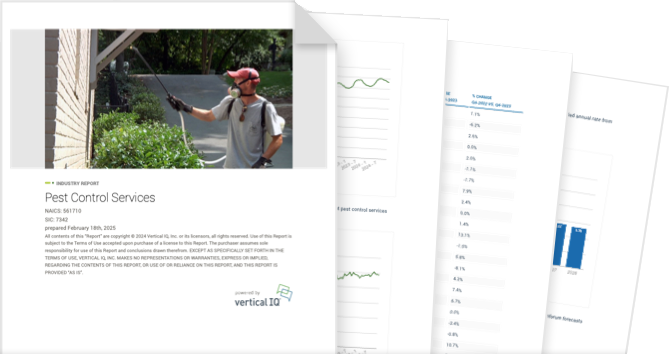Employment Services NAICS 5613

Unlock access to the full platform with more than 900 industry reports and local economic insights.
Get access to this Industry Profile including 18+ chapters and more than 50 pages of industry research.
Industry Summary
The 30,745 employment services firms in the US offer a wide range of employment-related services and solutions, including temporary and contract staffing, permanent placement, recruiting, outsourcing and outplacement, training, and human resource consulting. The industry is organized along three distinct segments: temporary help services, employment placement agencies, and professional employer organizations.
Online Job Sites and AI
The proliferation of Internet job sites and the increasing incorporation of AI to screen candidates and do mundane administrative work has made it easier for companies to advertise openings and find applicants on their own.
Growth of Flexible Workforces
Companies are placing increased value on the ability to quickly adjust to market conditions.
Recent Developments
Dec 19, 2025 - AI Could Already Replace More Than 10% of Workforce, Study Finds
- A Massachusetts Institute of Technology (MIT) study finds that artificial intelligence (AI) is already capable of performing work equal to 11.7% of the US labor market, meaning today’s AI systems could automate tasks now done by roughly one in nine workers. The study uses a new tool called the Iceberg Index, developed with Oak Ridge National Laboratory, to simulate how 151 million US workers’ skills overlap with thousands of existing AI tools and to measure “technical exposure,” instead of specific predictions of job cuts. When AI capabilities in administrative, financial, and professional services are included, the total exposed wage value reaches about $1.2 trillion. The research highlights that visible AI adoption in tech makes up only 2.2% of that exposure, suggesting much of AI’s potential impact lies beneath the surface. Researchers say the tool can help policymakers tailor reskilling and workforce planning at local levels.
- The US Court of Appeals for the Eleventh Circuit ruled that a staffing agency was not required to compensate workers for time spent waiting for and riding employer-provided transportation from a labor hall to jobsites, nor for time spent picking up or returning optional tools. The court held these activities were not “integral and indispensable” to the employees’ principal job duties and therefore fell outside compensable work time under the Portal-to-Portal Act, which limits what counts as paid time under the Fair Labor Standards Act. The court also allowed the employer to deduct transportation costs because the transit primarily benefited workers rather than the business. While binding only in Alabama, Florida, and Georgia, the decision reinforces a narrower view of compensable pre- and post-shift activities and could influence employers nationwide to reassess pay practices for travel, waiting time, and incidental tasks, potentially reducing wage-and-hour litigation exposure.
- About 1.1 million American jobs have been cut so far in 2025, up roughly 65% from the same period last year, according to career services company Challenger, Gray & Christmas. In October alone, employers announced about 153,000 cuts, triple the cuts from September and a 140% increase year over year. The largest reductions came from the federal government (~292,000 cuts), followed by technology (~89,000), retail (~80,000), and non-profits (~17,800). Workforce reductions in technology are being driven largely by AI adoption, accounting for over 10,000 cuts so far this year, and contributing to a 36% increase in sector layoffs compared with 2024. Government spending cuts not only affect federal employees, but Department of Government Efficiency reductions to grants and research continue to ripple into the nonprofit sector. Rising tariffs also remain a significant factor in the ongoing wave of workforce reductions.
- A recent McKinsey survey of more than 9,500 US adults found that remote flexibility remains a decisive factor in retaining skilled professionals. About 43% of prime-age employees (25-54) already work remotely, while nearly 60% want that option, creating a 17-point expectation gap that fuels resignations. Seventeen percent of recent quitters left after employers tightened in-office mandates, and three-quarters of college degree holders reject inflexible roles. Among those with bachelor’s degrees, 60% currently work remotely and 75% prefer it, while high-income households (making $100,000+) show even stronger preferences (up to 70% favoring remote work). The survey also found women prefer remote work 8 to 3 points more than men, meaning strict attendance policies can undermine diversity and retention. McKinsey data further link flexibility to performance: 35% of hybrid companies reported double-digit revenue growth versus 28% of office-bound firms. The results suggest that autonomy, not proximity, now defines workplace competitiveness.
Industry Revenue
Employment Services

Industry Structure
Industry size & Structure
A typical employment services firm has about 255 employees and annual revenues of $18 million.
- The overall industry consists of about 30,745 firms with 7.9 million employees and generates around $556.1 billion in annual revenue.
- About 58% of firms have less than 10 employees.
- The top 4 firms account for over 25% of industry revenue. The largest employment services firms include Adecco, Kelly Services, Manpower, Spherion, and Kforce.
- Temp workers average 35 hours per week per the US Bureau of Labor Statistics.
- Services are provided to customers in all employment segments.
- With limited capital costs associated with start-up, there is little barrier to entry into this field.
Industry Forecast
Industry Forecast
Employment Services Industry Growth

Vertical IQ Industry Report
For anyone actively digging deeper into a specific industry.
50+ pages of timely industry insights
18+ chapters
PDF delivered to your inbox
